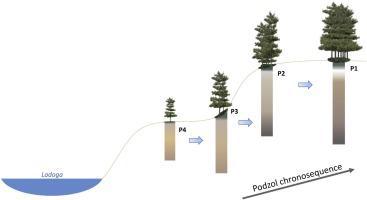当前位置:
X-MOL 学术
›
Pedobiologia
›
论文详情
Our official English website, www.x-mol.net, welcomes your feedback! (Note: you will need to create a separate account there.)
Shifting prokaryotic communities along a soil formation chronosequence and across soil horizons in a South Taiga ecosystem
Pedobiologia ( IF 2.3 ) Pub Date : 2020-09-01 , DOI: 10.1016/j.pedobi.2020.150650 Ekaterina A. Ivanova , Elizaveta V. Pershina , Vasilii M. Shapkin , Arina A. Kichko , Tatiana S. Aksenova , Anastasia K. Kimeklis , Grigorii V. Gladkov , Alexey O. Zverev , Nadezda A. Vasilyeva , Evgeny E. Andronov , Evgeny V. Abakumov
Pedobiologia ( IF 2.3 ) Pub Date : 2020-09-01 , DOI: 10.1016/j.pedobi.2020.150650 Ekaterina A. Ivanova , Elizaveta V. Pershina , Vasilii M. Shapkin , Arina A. Kichko , Tatiana S. Aksenova , Anastasia K. Kimeklis , Grigorii V. Gladkov , Alexey O. Zverev , Nadezda A. Vasilyeva , Evgeny E. Andronov , Evgeny V. Abakumov

|
Abstract The study of chronosequences allows the analysis of the temporal and spatial dynamics of ecogenesis, soil microbiome and soil development. Here, we investigated the taxonomic diversity of bacterial and archaeal communities along a chronosequence of soils that formed on four Lake Ladoga coastal bars in the Nizhnesvirsky Nature Reserve (Leningrad region, north-west Russian Federation). We analyzed two factors: the age of sampled solum (ranging from 70 to 1,590 years) and the soil horizons that differ in terms of morphology and genesis. We observed a relationship between podzolisation, typical major soil-forming processes of the southern taiga zone, and the taxonomic structure of prokaryotic communities. The most pronounced differences between microbial communities were associated with the vertical heterogeneity of soil profile. Phyla associated with copiotrophic habits (Proteobacteria, Actinobacteria and Bacteroidetes) were more frequent in topsoil. Podzolic eluvial (E) horizons had higher frequencies of the genus Mycobacterium (Actinobacteria). In deeper horizons, we observed lower frequencies of copiotrophic phyla and increased frequencies of phyla associated with oligotrophic habits (Nitrospirae, Gemmatomonadetes, Planctomycetes, Chloroflexi, etc.), as well as archaeal lineages. The lowest (gleyic, G) horizons had high frequencies of anaerobic and methane-producing bacteria. Therefore, the relationship between microbial community structure and the continuous development of the soil profile was revealed. Shifting physico-chemical were identified as key factors associated with variation in prokaryotic communities. The older coastal bar demonstrated the clearer signs of podzol formation, increased thickness of the E horizon, and increased differentiation among microbial communities in different genetic horizons.
中文翻译:

在南针叶林生态系统中沿土壤形成时间序列和跨土壤层移动原核生物群落
摘要 时间序列的研究可以分析生态发生、土壤微生物组和土壤发育的时空动态。在这里,我们沿着在 Nizhnesvirsky 自然保护区(列宁格勒地区,俄罗斯联邦西北部)的四个拉多加湖沿岸酒吧形成的土壤的时间序列调查了细菌和古菌群落的分类多样性。我们分析了两个因素:采样的 solum 的年龄(范围从 70 到 1,590 年)和在形态和成因方面不同的土壤层。我们观察到灰化、南部针叶林区典型的主要土壤形成过程与原核生物群落的分类结构之间的关系。微生物群落之间最显着的差异与土壤剖面的垂直异质性有关。与营养习性相关的门(变形菌、放线菌和拟杆菌)在表土中更常见。Podzolic eluvial (E) 层具有较高频率的分枝杆菌属(放线菌)。在更深的视野中,我们观察到与寡营养习性(硝化螺旋藻、Gemmatomonadetes、浮游菌、Chloroflexi 等)以及古菌谱系相关的营养性门的频率较低,而门的频率增加。最低(gleyic,G)层有高频率的厌氧菌和产甲烷菌。因此,揭示了微生物群落结构与土壤剖面不断发展之间的关系。改变物理化学被确定为与原核生物群落变异相关的关键因素。
更新日期:2020-09-01
中文翻译:

在南针叶林生态系统中沿土壤形成时间序列和跨土壤层移动原核生物群落
摘要 时间序列的研究可以分析生态发生、土壤微生物组和土壤发育的时空动态。在这里,我们沿着在 Nizhnesvirsky 自然保护区(列宁格勒地区,俄罗斯联邦西北部)的四个拉多加湖沿岸酒吧形成的土壤的时间序列调查了细菌和古菌群落的分类多样性。我们分析了两个因素:采样的 solum 的年龄(范围从 70 到 1,590 年)和在形态和成因方面不同的土壤层。我们观察到灰化、南部针叶林区典型的主要土壤形成过程与原核生物群落的分类结构之间的关系。微生物群落之间最显着的差异与土壤剖面的垂直异质性有关。与营养习性相关的门(变形菌、放线菌和拟杆菌)在表土中更常见。Podzolic eluvial (E) 层具有较高频率的分枝杆菌属(放线菌)。在更深的视野中,我们观察到与寡营养习性(硝化螺旋藻、Gemmatomonadetes、浮游菌、Chloroflexi 等)以及古菌谱系相关的营养性门的频率较低,而门的频率增加。最低(gleyic,G)层有高频率的厌氧菌和产甲烷菌。因此,揭示了微生物群落结构与土壤剖面不断发展之间的关系。改变物理化学被确定为与原核生物群落变异相关的关键因素。



























 京公网安备 11010802027423号
京公网安备 11010802027423号